-
 NEWHardcover, 305 x 258 mm, black cloth with gilt lettering to spine, black pictorial dust jacket with white lettering to front and spine, olive endpapers; pp. [1-5] 6-144, 150 colour illustrations. ISBN 185177 316. Title-page: JAPANESE TEXTILES | IN THE VICTORIA AND ALBERT MUSEUM | Anna Jackson | Photographs by Ian Thomas | V&A PUBLICATIONS || Contents Acknowledgements Introduction Map Japanese textiles List of plates The plates Bibliography
NEWHardcover, 305 x 258 mm, black cloth with gilt lettering to spine, black pictorial dust jacket with white lettering to front and spine, olive endpapers; pp. [1-5] 6-144, 150 colour illustrations. ISBN 185177 316. Title-page: JAPANESE TEXTILES | IN THE VICTORIA AND ALBERT MUSEUM | Anna Jackson | Photographs by Ian Thomas | V&A PUBLICATIONS || Contents Acknowledgements Introduction Map Japanese textiles List of plates The plates Bibliography -
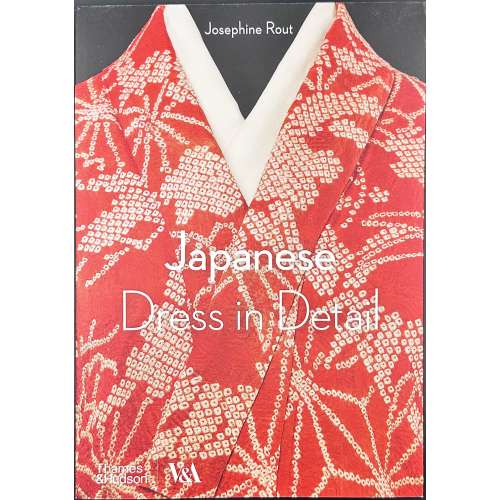 NEWPaperback, 2nd edition, 290 x 205 mm, publisher’s pictorial wrappers with large flaps, white lettering, pp.: [1-6] 7-208, 198 illustrations, with glossary and 2½ pp. index. 1st edition published in 2020. Title-page: Japanese | Dress in Detail | Josephine Rout | with Anna Jackson | {Thames |&Hudson / V&A} || Contents: Introduction
NEWPaperback, 2nd edition, 290 x 205 mm, publisher’s pictorial wrappers with large flaps, white lettering, pp.: [1-6] 7-208, 198 illustrations, with glossary and 2½ pp. index. 1st edition published in 2020. Title-page: Japanese | Dress in Detail | Josephine Rout | with Anna Jackson | {Thames |&Hudson / V&A} || Contents: Introduction- Necklines and Shoulders
- Headwear
- Sleeves
- Waists
- Waist Accessories
- Hems
- Linings and Undergarments
- Footwear
-
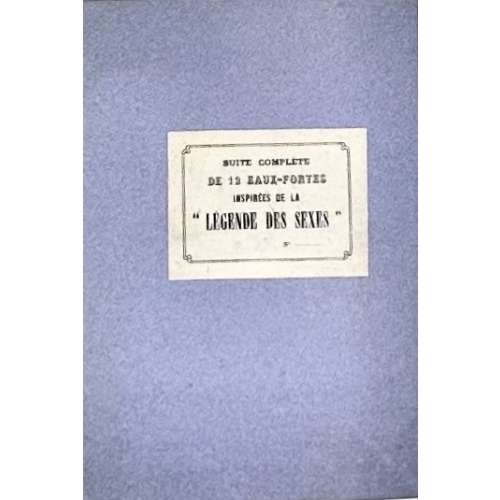 NEWTwelve etchings printed in black on laid paper, uncoloured, sheet 236 x 140 mm, platemark 155 x 100 mm, red ink stamp “ARS EROTICA | Hans-J. Döpp” to verso; image title in pencil to recto of some sheets. Pale ‘remarque’ on the lower margin of plate 2 ‘L’Eden’. Traces of original binding along the right edge. No folder. Catalogue raisonné: Luc Binet 2017: 100-B, pp. 639-51 ; S. A. Perry 2015: 80, p. 70-1.
NEWTwelve etchings printed in black on laid paper, uncoloured, sheet 236 x 140 mm, platemark 155 x 100 mm, red ink stamp “ARS EROTICA | Hans-J. Döpp” to verso; image title in pencil to recto of some sheets. Pale ‘remarque’ on the lower margin of plate 2 ‘L’Eden’. Traces of original binding along the right edge. No folder. Catalogue raisonné: Luc Binet 2017: 100-B, pp. 639-51 ; S. A. Perry 2015: 80, p. 70-1.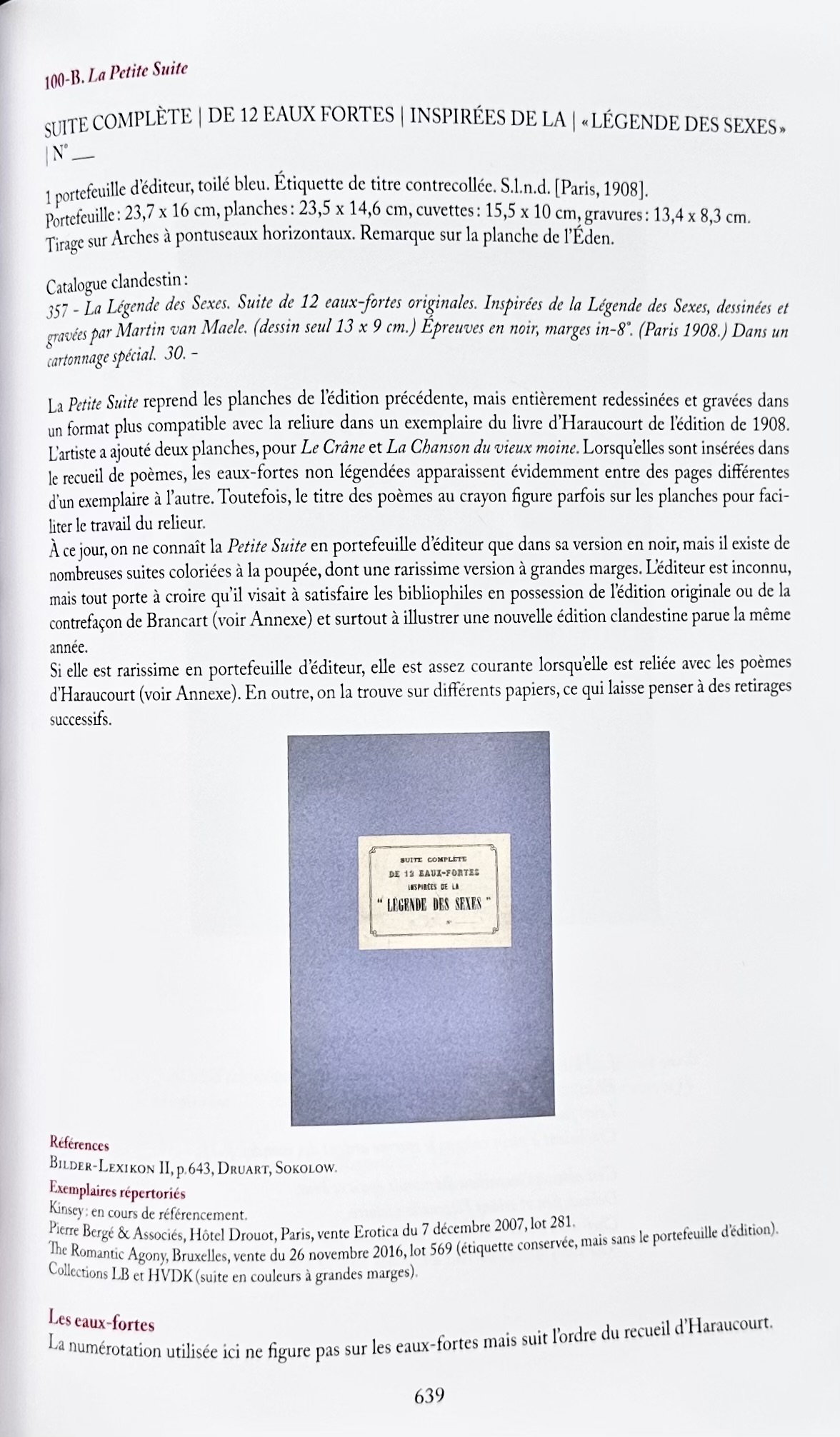 List of images:
List of images:
- Le Coït des Atomes
- L’Éden
- La Flûte
- Portes d’enfer
- Danaë
- L’obsession
- Europe
- Le crâne
- Mélancolie blennorhagique [sic]
- Parisienne
- La chanson du vieux moine
- Reine du monde
-
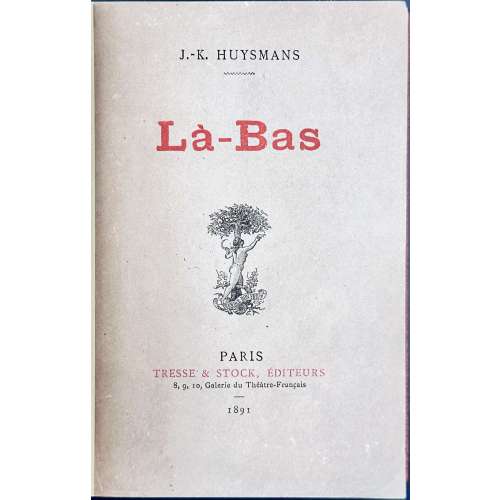 NEWBook: Hardcover, 187 x 125 mm, modern binding ‘à la Bradel’ by Boichot in full orange morocco with gilt lettering to spine, in a morocco-bordered slipcase with gilt floral arabesque design, similar endpapers; original wrappers preserved; collated in 18mo, pp: [4] 1-441 [3]. Bookplate of Jean-Pierre Dutel to ffl. Fifteen illustrations 181 x 115 mm tipped in after pp. 46, 72, 88, 118, 202, 234, 236, 244, 290, 300, 354, 360, 378, 382, and 390. Front wrapper (red and black): J.-K. HUYSMANS | ~~ | Là-Bas | {publisher’s device} | PARIS | TRESSE & STOCK, ÉDITEURS | 8, 9, 10, Galerie du Théâtre-Français | — | 1891 || Title-page: same as wrapper, in black. Limitation: Il a été tiré de cet ouvrage dix exemplaires sur papier de Hollande et dix exemplaires sur papier du Japon, numérotés à la presse. This copy is not from the limited edition and printed on a regular paper. Printer: Darantiere (Dijon) Illustrations: According to Luc Binet [LIB-3301.2024], “In 2016, the Turin bookseller Roberto Cena put up for sale two full-leather bound albums, one containing watercolours illustrating Huysmans' famous novel, the other the preparatory drawings. The first volume contained 16 plates (sheet 25 x 16.5 cm, drawing 15 x 9.5 cm), i.e. 15 drawings in ink and pencil and one pencil drawing. Each plate is numbered at the top right, in pencil or ink, and captioned in the lower margin. Volume II contained 15 watercolours (sheet 25 x 16 cm, image 15 x 9.5 cm). This is probably a commission from a bibliophile since the chosen format is perfectly compatible with the original edition of Huysmans' text (19 x 13 cm)”.
NEWBook: Hardcover, 187 x 125 mm, modern binding ‘à la Bradel’ by Boichot in full orange morocco with gilt lettering to spine, in a morocco-bordered slipcase with gilt floral arabesque design, similar endpapers; original wrappers preserved; collated in 18mo, pp: [4] 1-441 [3]. Bookplate of Jean-Pierre Dutel to ffl. Fifteen illustrations 181 x 115 mm tipped in after pp. 46, 72, 88, 118, 202, 234, 236, 244, 290, 300, 354, 360, 378, 382, and 390. Front wrapper (red and black): J.-K. HUYSMANS | ~~ | Là-Bas | {publisher’s device} | PARIS | TRESSE & STOCK, ÉDITEURS | 8, 9, 10, Galerie du Théâtre-Français | — | 1891 || Title-page: same as wrapper, in black. Limitation: Il a été tiré de cet ouvrage dix exemplaires sur papier de Hollande et dix exemplaires sur papier du Japon, numérotés à la presse. This copy is not from the limited edition and printed on a regular paper. Printer: Darantiere (Dijon) Illustrations: According to Luc Binet [LIB-3301.2024], “In 2016, the Turin bookseller Roberto Cena put up for sale two full-leather bound albums, one containing watercolours illustrating Huysmans' famous novel, the other the preparatory drawings. The first volume contained 16 plates (sheet 25 x 16.5 cm, drawing 15 x 9.5 cm), i.e. 15 drawings in ink and pencil and one pencil drawing. Each plate is numbered at the top right, in pencil or ink, and captioned in the lower margin. Volume II contained 15 watercolours (sheet 25 x 16 cm, image 15 x 9.5 cm). This is probably a commission from a bibliophile since the chosen format is perfectly compatible with the original edition of Huysmans' text (19 x 13 cm)”.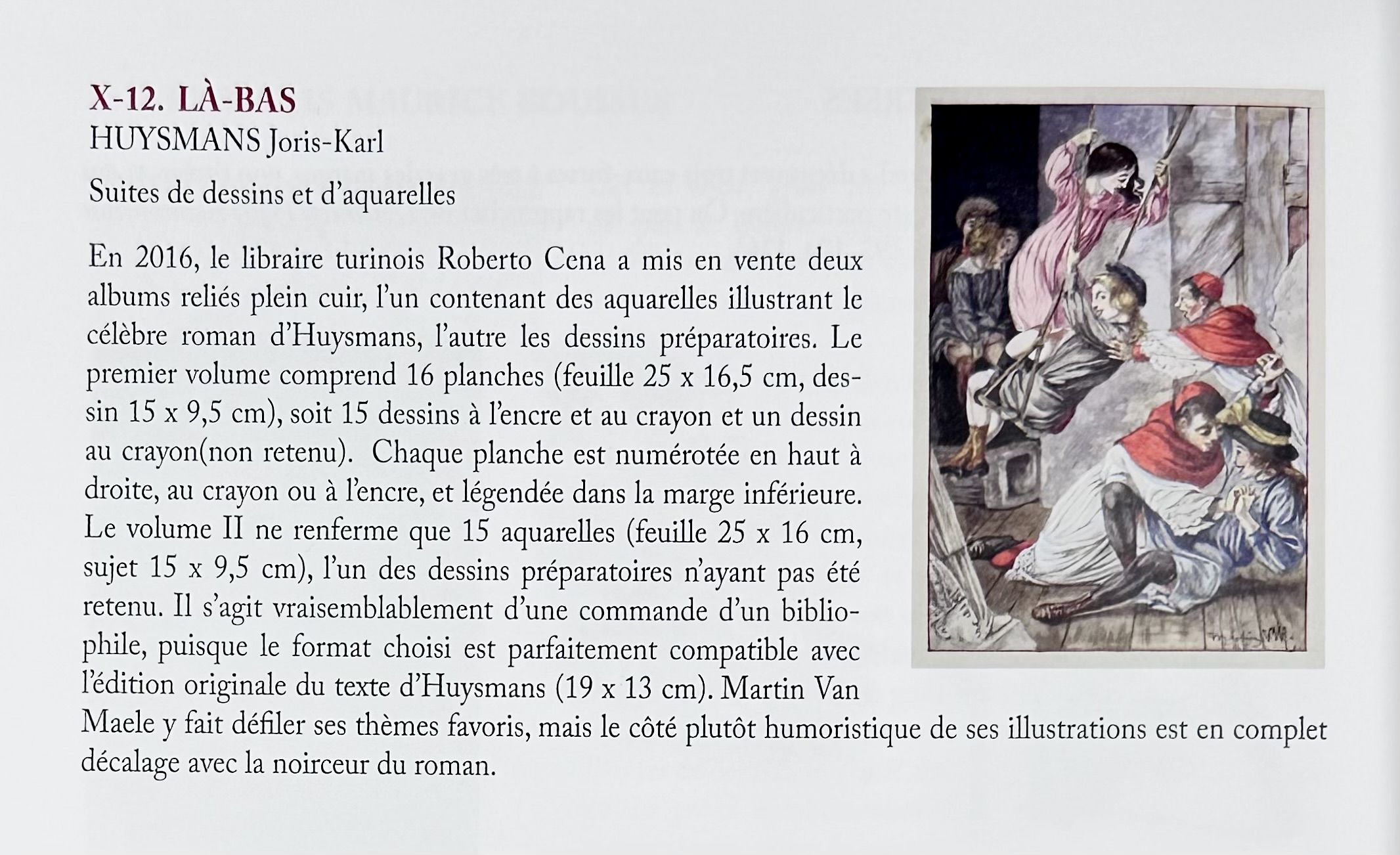 Catalogue raisonné: Luc Binet 2017: X-12, p. 908.
Contributors:
Huysmans, Joris-Karl (French, 1848 – 1907) – author.
Maële, Martin van (French, 1863 – 1926) – artist.
Darantiere, Maurice (French, 1882 – 1962) – printer.
Catalogue raisonné: Luc Binet 2017: X-12, p. 908.
Contributors:
Huysmans, Joris-Karl (French, 1848 – 1907) – author.
Maële, Martin van (French, 1863 – 1926) – artist.
Darantiere, Maurice (French, 1882 – 1962) – printer. -
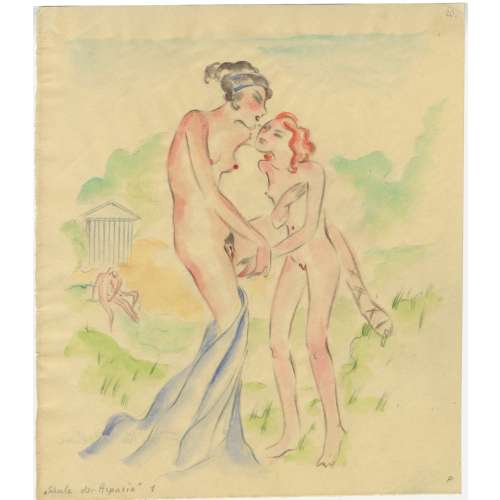 NEWPencil and watercolour on paper 230 x 197 mm, pencil ms inscription in the bottom-left “Schule der Aspasia” 1 (2, 3), monogrammed “P” in the bottom-right, and “Erika Plehn” to verso. Apparently, illustrations for ‘Die Weisheiten der Aspasia’ also known as ‘Die Dirnenschule der Aspasia’ (Aspasia's prostitute school), an erotic novel by Fritz Thurn (Foregger), privately published in Vienna in 1923. Artist: Erika Plehn [née Erika Pinkus] (German, 1904 – 1988) Author: Fritz Thurn [Foregger zum Greiffenthurn] (Austrian, 1877 – 1938). Aspasia of Miletus (Greek, c. 464 BCE – c. 420 BCE)
NEWPencil and watercolour on paper 230 x 197 mm, pencil ms inscription in the bottom-left “Schule der Aspasia” 1 (2, 3), monogrammed “P” in the bottom-right, and “Erika Plehn” to verso. Apparently, illustrations for ‘Die Weisheiten der Aspasia’ also known as ‘Die Dirnenschule der Aspasia’ (Aspasia's prostitute school), an erotic novel by Fritz Thurn (Foregger), privately published in Vienna in 1923. Artist: Erika Plehn [née Erika Pinkus] (German, 1904 – 1988) Author: Fritz Thurn [Foregger zum Greiffenthurn] (Austrian, 1877 – 1938). Aspasia of Miletus (Greek, c. 464 BCE – c. 420 BCE) -
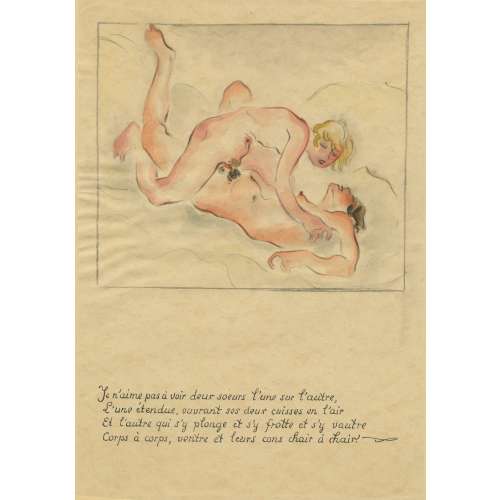 NEWFramed pencil and watercolour drawings with 4-line manuscript pen and ink French text under the frame on paper 255 x 175 mm mounted on card stock sheets 290 x 210 mm. Illustrations correspond to the 1st edition of Pierre Louÿs’ « Pybrac / Poésies » published by Cythère Au coq hardi in 1927 [LIB-3061.2022], pp. 25, 37, 64, 69, 85, 86, and 94. Illustrations here are placed in the order they would have appeared in the book.
NEWFramed pencil and watercolour drawings with 4-line manuscript pen and ink French text under the frame on paper 255 x 175 mm mounted on card stock sheets 290 x 210 mm. Illustrations correspond to the 1st edition of Pierre Louÿs’ « Pybrac / Poésies » published by Cythère Au coq hardi in 1927 [LIB-3061.2022], pp. 25, 37, 64, 69, 85, 86, and 94. Illustrations here are placed in the order they would have appeared in the book.- Je n’aime pas à voir deux sœurs l’une sur l’autre, L’une étendue, ouvrant ses deux cuisses en l’air, Et l’autre qui s’y plonge et s’y frotte et s’y vautre, Corps à corps, ventre à ventre et leurs cons chair à chair.
- Je n’aime pas à voir la douce concubine Qu’on encule toujours et qui, d’un doigt lascif Se branle le bouton, se tire la barbiche, Pour soulager son cul douloureux et passif
- Je n’aime pas à voir cette Sappho mascule Qui, dans sa chambre, habille une fille en garçon, Lui baisse la culotte et froidement l’encule Avec un godmiché plus gros qu’un saucisson.
- Je n’aime pas à voir la vierge au doigt lubrique Qui, les deux pieds en l’air, masturbe sur le lit Son pucelage en rut, gonflé, couleur de brique, Et décharge en baisant le roman qu’elle lit.
- Je n’aime pas à voir le garçon sur la fille Donner des coups au cul et danser le galop Aux applaudissements de toute la famille Qui dit : « Ça vient, putain ! Fais-la jouir, salop ! »
- Je n’aime pas à voir la princesse de Grèce, Qui, menée au bordel par sa fille d’honneur, Frotte sa bouche obscène au cul de la négresse Et crie en déchargeant : « C’est là qu’est le bonheur ! »
- Je n’aime pas à voir dans un bal de familles Que l’hôtesse dispose une chambre d’ami Et des lits de repos, au gré des jeunes filles, Pour sucer leurs danseurs ou se faire mimi.
-
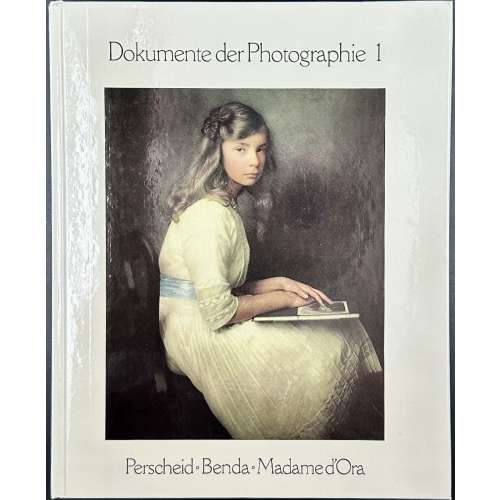 NEWHardcover, 240 x 192 mm, glossy pictorial boards, lettering to front and spine, pp.: [1-5] 6-171 [172], with 308 plates in colour and b/w. Catalogue of the exhibition held on March 26 – June 1, 1980, at Museum für Kunst und Gewerbe in Hamburg. Title-page: DOKUMENTE DER PHOTOGRAPHIE 1 | FRITZ KEMPE | NICOLA PERSCHEID | ARTHUR BENDA | MADAME D'ORA | Katalog bearbeitet | von Odette M. Appel-Heyne | MUSEUM FUR KUNST UND GEWERBE HAMBURG 1980 || Contributors: Kempe, Fritz (German, 1909 –1988) – author Appel-Heyne, Odette M. – editor Kallmus, Dora [Madame d’Ora] (Austrian-Jewish, 1881 – 1963) – photographer Perscheid, Nicola (German, 1864 – 1930) – photographer Benda, Arthur (German, 1885 – 1969) – photographer
NEWHardcover, 240 x 192 mm, glossy pictorial boards, lettering to front and spine, pp.: [1-5] 6-171 [172], with 308 plates in colour and b/w. Catalogue of the exhibition held on March 26 – June 1, 1980, at Museum für Kunst und Gewerbe in Hamburg. Title-page: DOKUMENTE DER PHOTOGRAPHIE 1 | FRITZ KEMPE | NICOLA PERSCHEID | ARTHUR BENDA | MADAME D'ORA | Katalog bearbeitet | von Odette M. Appel-Heyne | MUSEUM FUR KUNST UND GEWERBE HAMBURG 1980 || Contributors: Kempe, Fritz (German, 1909 –1988) – author Appel-Heyne, Odette M. – editor Kallmus, Dora [Madame d’Ora] (Austrian-Jewish, 1881 – 1963) – photographer Perscheid, Nicola (German, 1864 – 1930) – photographer Benda, Arthur (German, 1885 – 1969) – photographer -
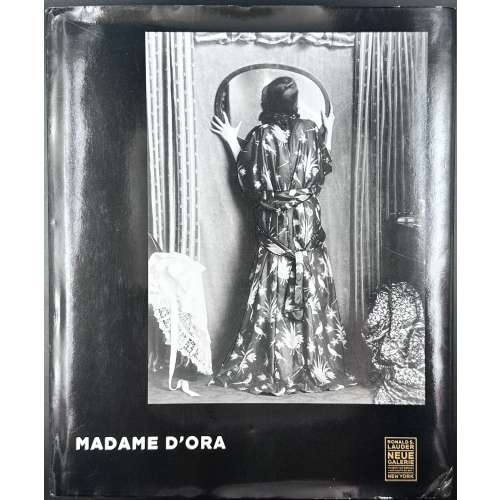 NEWHardcover, 290 x 240 mm, blue cloth with gilt lettering to spine, grey endpapers, in a black and white pictorial dust jacket with white lettering, pp.: [1-5] 6-231 [232], with 114 plates. Catalogue of an exhibition held at the Neue Galerie, NY, February 20—June 8, 2020. Title-page (white on black): MADAME D'ORA | Edited by Monika Faber | With preface by Ronald S. Lauder, foreword by Renée Price, | and contributions by Katrin Bomhoff Christian Brandstätter, Jean-Marc Dreyfus, | Monica Faber, Esther Ruelfs, Lisa Silverman, and Magdalena Vuković | PRESTEL | MUNICH • LONDON • NEW YORK | photoinstitut | BONARTES / MK&G / MUSEUM FÜR | KUNST UND GEWERBE | HAMBURG || Contributors: Kallmus, Dora [Madame d'Ora] (Austrian-Jewish, 1881 – 1963) – photographer Neue Galerie New York – museum of early twentieth-century German and Austrian art and design. Lauder, Ronald Steven (American-Jewish, b. 1944) – the owner of Neue Galerie.
NEWHardcover, 290 x 240 mm, blue cloth with gilt lettering to spine, grey endpapers, in a black and white pictorial dust jacket with white lettering, pp.: [1-5] 6-231 [232], with 114 plates. Catalogue of an exhibition held at the Neue Galerie, NY, February 20—June 8, 2020. Title-page (white on black): MADAME D'ORA | Edited by Monika Faber | With preface by Ronald S. Lauder, foreword by Renée Price, | and contributions by Katrin Bomhoff Christian Brandstätter, Jean-Marc Dreyfus, | Monica Faber, Esther Ruelfs, Lisa Silverman, and Magdalena Vuković | PRESTEL | MUNICH • LONDON • NEW YORK | photoinstitut | BONARTES / MK&G / MUSEUM FÜR | KUNST UND GEWERBE | HAMBURG || Contributors: Kallmus, Dora [Madame d'Ora] (Austrian-Jewish, 1881 – 1963) – photographer Neue Galerie New York – museum of early twentieth-century German and Austrian art and design. Lauder, Ronald Steven (American-Jewish, b. 1944) – the owner of Neue Galerie. -
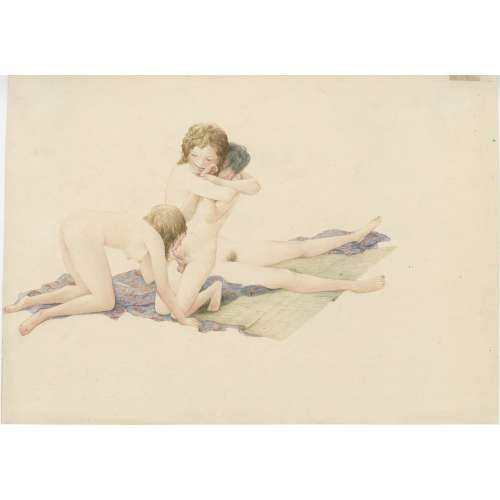 NEWWatercolour on paper, 205 x 292 mm; fuchsia ink stamp "ARS EROTICA | Hans-J. Döpp" to verso, remains of hinges. Untitled. Artist: Otto Rudolf Schatz (Austrian, 1900 – 1961).
NEWWatercolour on paper, 205 x 292 mm; fuchsia ink stamp "ARS EROTICA | Hans-J. Döpp" to verso, remains of hinges. Untitled. Artist: Otto Rudolf Schatz (Austrian, 1900 – 1961). -
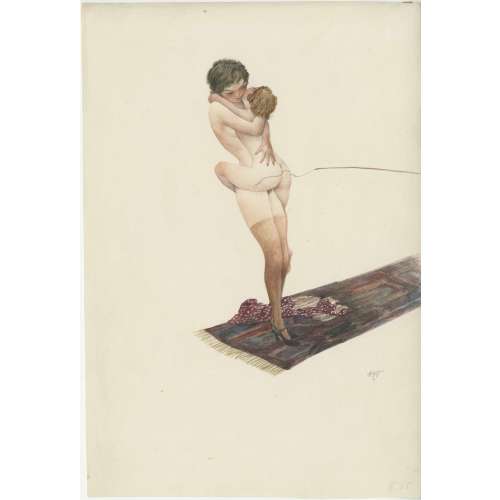 NEWWatercolour on paper, 299 x 205 mm, monogrammed "ORSx" under the image; to verso: blue ink Hungarian export mark "KIVITELRE ENGEDELYEZVE O. Sz. M." and fuchsia ink stamp ARS EROTICA | Hans-J. Döpp. Untitled. Artist: Otto Rudolf Schatz (Austrian, 1900 – 1961).
NEWWatercolour on paper, 299 x 205 mm, monogrammed "ORSx" under the image; to verso: blue ink Hungarian export mark "KIVITELRE ENGEDELYEZVE O. Sz. M." and fuchsia ink stamp ARS EROTICA | Hans-J. Döpp. Untitled. Artist: Otto Rudolf Schatz (Austrian, 1900 – 1961). -
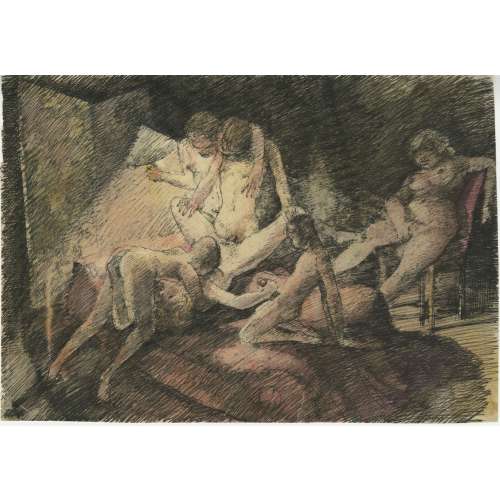 NEWWatercolour, pen and ink on paper, 195 x 282 mm; to verso: black ink stamp “Nachlaß O R SCHATZ" and fuchsia ink stamp ARS EROTICA | Hans-J. Döpp; traces of mounting and repair. Untitled. Artist: Otto Rudolf Schatz (Austrian, 1900 – 1961).
NEWWatercolour, pen and ink on paper, 195 x 282 mm; to verso: black ink stamp “Nachlaß O R SCHATZ" and fuchsia ink stamp ARS EROTICA | Hans-J. Döpp; traces of mounting and repair. Untitled. Artist: Otto Rudolf Schatz (Austrian, 1900 – 1961). -
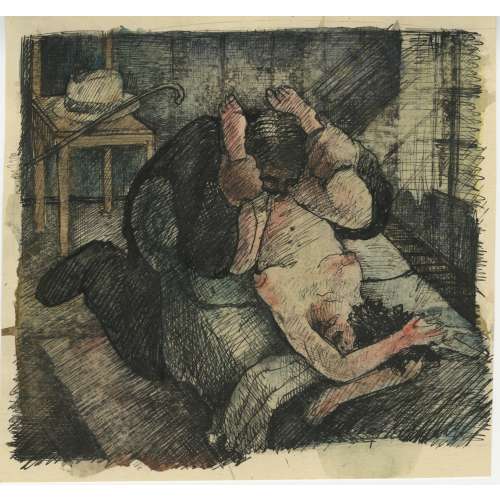 NEWWatercolour, India ink, pen and ink on card stock, 165 x 174 mm; to verso: black ink stamp “Nachlaß O R SCHATZ" and fuchsia ink stamp ARS EROTICA | Hans-J. Döpp; traces of mounting. Untitled. Artist: Otto Rudolf Schatz (Austrian, 1900 – 1961).
NEWWatercolour, India ink, pen and ink on card stock, 165 x 174 mm; to verso: black ink stamp “Nachlaß O R SCHATZ" and fuchsia ink stamp ARS EROTICA | Hans-J. Döpp; traces of mounting. Untitled. Artist: Otto Rudolf Schatz (Austrian, 1900 – 1961). -
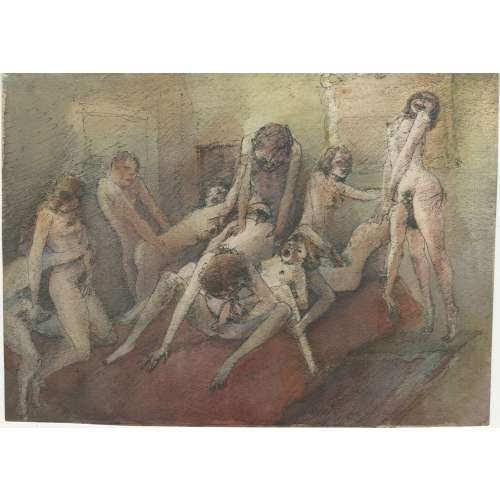 NEWWatercolour, pen and black ink on card stock, 179 x 247 mm; pencil inscription to verso "Otto Rudolf Schatz 3233-03", traces of mounting. Untitled. Artist: Otto Rudolf Schatz (Austrian, 1900 – 1961).
NEWWatercolour, pen and black ink on card stock, 179 x 247 mm; pencil inscription to verso "Otto Rudolf Schatz 3233-03", traces of mounting. Untitled. Artist: Otto Rudolf Schatz (Austrian, 1900 – 1961). -
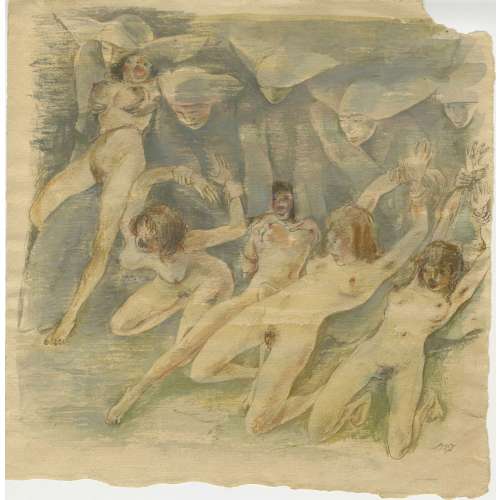 NEWWatercolour, pen and ink wash on thick wove paper, 295 x 298 mm, monogrammed in the bottom right corner "ORSx"; pencil inscription to verso "Um 1950 Otto Rudolf Schatz 3233-03"; two margins cut, traces of mounting on top margin. Untitled. Artist: Otto Rudolf Schatz (Austrian, 1900 – 1961).
NEWWatercolour, pen and ink wash on thick wove paper, 295 x 298 mm, monogrammed in the bottom right corner "ORSx"; pencil inscription to verso "Um 1950 Otto Rudolf Schatz 3233-03"; two margins cut, traces of mounting on top margin. Untitled. Artist: Otto Rudolf Schatz (Austrian, 1900 – 1961). -
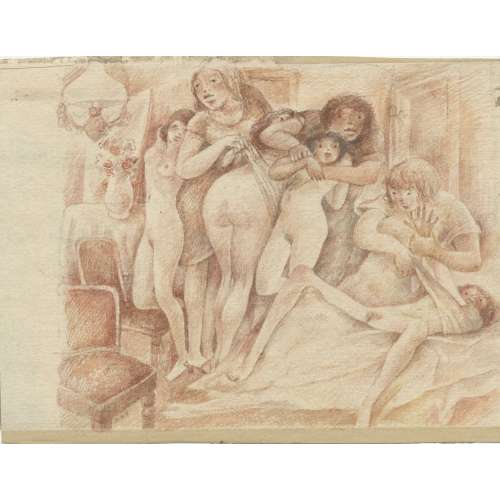 NEWWatercolour, pen and ink on thick wove paper, 177 x 235 mm; to verso: blue ink stamp “Nachlaß O R SCHATZ" and fuchsia ink stamp ARS EROTICA | Hans-J. Döpp; traces of framing along all the margins; traces of framing along the margins; remains of hinges. Artist: Otto Rudolf Schatz (Austrian, 1900 – 1961).
NEWWatercolour, pen and ink on thick wove paper, 177 x 235 mm; to verso: blue ink stamp “Nachlaß O R SCHATZ" and fuchsia ink stamp ARS EROTICA | Hans-J. Döpp; traces of framing along all the margins; traces of framing along the margins; remains of hinges. Artist: Otto Rudolf Schatz (Austrian, 1900 – 1961). -
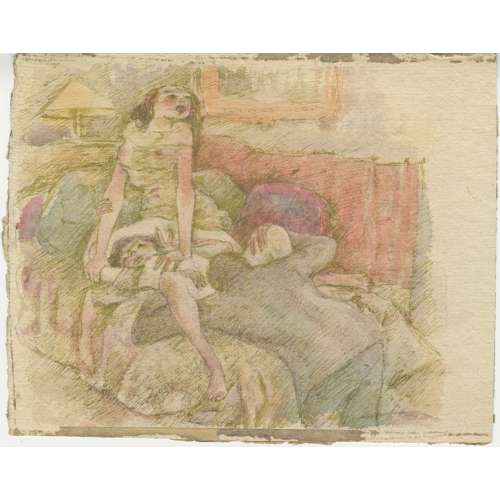 NEWWatercolour, pen and ink on thick wove paper, 180 x 220 mm; to verso: blue ink stamp “PROF O. R. SCHATZ | Wien II, Gr. Mohreng 3b | Tel.: 55 82 566”; fuchsia ink stamp "ARS EROTICA | Hans-J. Döpp"; traces of framing along the margins. Artist: Otto Rudolf Schatz (Austrian, 1900 – 1961).
NEWWatercolour, pen and ink on thick wove paper, 180 x 220 mm; to verso: blue ink stamp “PROF O. R. SCHATZ | Wien II, Gr. Mohreng 3b | Tel.: 55 82 566”; fuchsia ink stamp "ARS EROTICA | Hans-J. Döpp"; traces of framing along the margins. Artist: Otto Rudolf Schatz (Austrian, 1900 – 1961). -
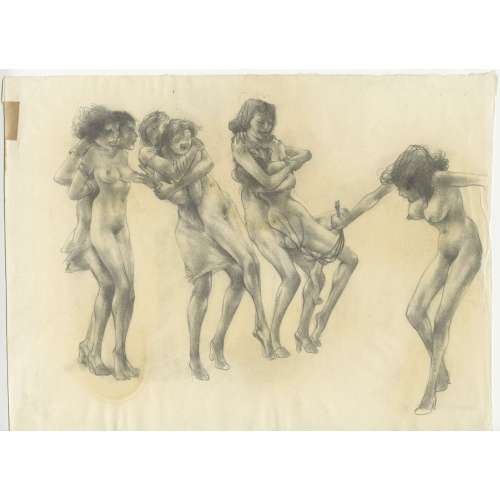 NEWGraphite on wove paper, 250 x 340 mm, blue ink stamp to verso: “Nachlaß O R SCHATZ"; margins trimmed unevenly, traces of hinges. Artist: Otto Rudolf Schatz (Austrian, 1900 – 1961).
NEWGraphite on wove paper, 250 x 340 mm, blue ink stamp to verso: “Nachlaß O R SCHATZ"; margins trimmed unevenly, traces of hinges. Artist: Otto Rudolf Schatz (Austrian, 1900 – 1961). -
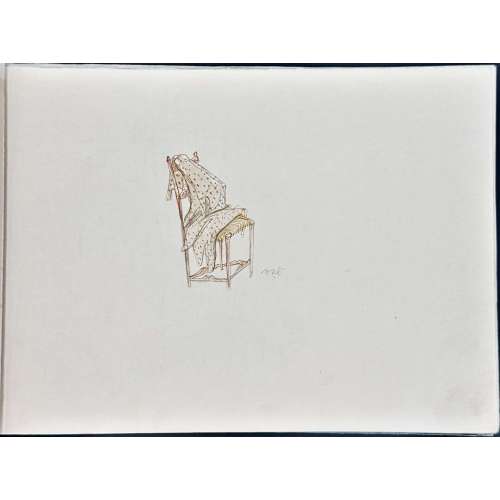 NEWJapanese-style bound oblong horizontal album of 20 colour drawings (watercolour and pencil on paper), 187 x 269 mm, monogrammed on the first page ORS, signed and dated on the last page O. R. SCHATZ | 1954 | x || Artist: Otto Rudolf Schatz (Austrian, 1900 – 1961).
NEWJapanese-style bound oblong horizontal album of 20 colour drawings (watercolour and pencil on paper), 187 x 269 mm, monogrammed on the first page ORS, signed and dated on the last page O. R. SCHATZ | 1954 | x || Artist: Otto Rudolf Schatz (Austrian, 1900 – 1961). -
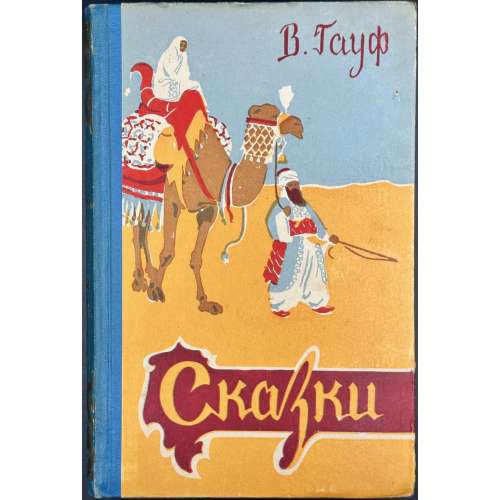 NEWHardcover, 208 x 135 mm, quarter blue cloth over pictorial cardboard, gilt elements and lettering to spine, collated 8vo: 1-218 χ2, i.e. 170 leaves, pp.: [1-4] 5-336 [4]. Title-page (blue and black): В. Гауф | {vignette} | Сказки | {vignette} | ИВАНОВСКОЕ КНИЖНОЕ ИЗДАТЕЛЬСТВО – 1959 || Contents: КАРАВАН. Перевод Н. Г. Касаткиной Рассказ о калифе аисте Рассказ о корабле приведений Рассказ об отрубленной руке Спасение Фатимы Рассказ о Маленьком Муке Сказка о мнимом принце АЛЕКСАНДРИЙСКИЙ ШЕЙХ И ЕГО НЕВОЛЬНИКИ. Перевод И. С. Татариновой Карлик Нос Обезьяна в роли человека История Альмансора ХАРЧЕВНЯ В ШПЕССАРТЕ. Перевод М. А. Полиевктовой Рассказ о гульдене с изображением оленя Холодное сердце. Часть первая. Приключения Саида Стинфольская пещера. Шотландское предание Холодное сердце. Часть вторая. Contributors: Wilhelm Hauff [Вильгельм Гауф] (German, 1802 – 1827) – author. Касаткина, Наталья Григорьевна (Russian, 1902 – 1985) – translator Татаринова, Ирина Сергеевна (Russian, 1895 – 1978) – translator Полиевктова, Мария Александровна (Russian, 1892 – 1982) – translator
NEWHardcover, 208 x 135 mm, quarter blue cloth over pictorial cardboard, gilt elements and lettering to spine, collated 8vo: 1-218 χ2, i.e. 170 leaves, pp.: [1-4] 5-336 [4]. Title-page (blue and black): В. Гауф | {vignette} | Сказки | {vignette} | ИВАНОВСКОЕ КНИЖНОЕ ИЗДАТЕЛЬСТВО – 1959 || Contents: КАРАВАН. Перевод Н. Г. Касаткиной Рассказ о калифе аисте Рассказ о корабле приведений Рассказ об отрубленной руке Спасение Фатимы Рассказ о Маленьком Муке Сказка о мнимом принце АЛЕКСАНДРИЙСКИЙ ШЕЙХ И ЕГО НЕВОЛЬНИКИ. Перевод И. С. Татариновой Карлик Нос Обезьяна в роли человека История Альмансора ХАРЧЕВНЯ В ШПЕССАРТЕ. Перевод М. А. Полиевктовой Рассказ о гульдене с изображением оленя Холодное сердце. Часть первая. Приключения Саида Стинфольская пещера. Шотландское предание Холодное сердце. Часть вторая. Contributors: Wilhelm Hauff [Вильгельм Гауф] (German, 1802 – 1827) – author. Касаткина, Наталья Григорьевна (Russian, 1902 – 1985) – translator Татаринова, Ирина Сергеевна (Russian, 1895 – 1978) – translator Полиевктова, Мария Александровна (Russian, 1892 – 1982) – translator -
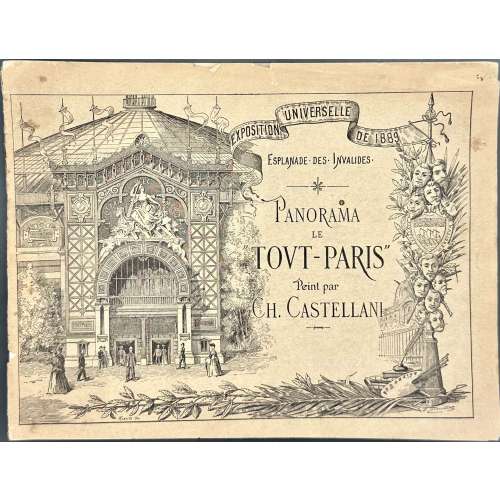 NEWSoftcover, 193 x 252 mm, pictorial wrappers, lettered, 24 leaves numbered on recto 2-23 with 23 photogravures after Charles Castellani and advertisement to verso. Front wrapper: (ribbon) EXPOSITION UNIVERSELLE DE 1889 | ESPLANADE • DES • INVALIDES • | — | PANORAMA | LE | ”TOVT – PARIS” | peint par | Ch. Castellani | — || Title-page: (in frame) PANORAMA | LE | “TOUT – PARIS” | PEINT PAR | CH. CASTELLANI || Ref: BNF, département Estampes et photographie, 4-NA-62; Getty Research Institute Accession Number 2623-796. Contributors: Charles Castellani (French, 1838 – 1913) Arents, Pierre-Marie (Belgian, 1842 – 1916) Characters: Fouquier, Henry (French, 1838 – 1901) Bernhardt, Sarah [Bernard, Henriette-Rosine] (French, 1844 – 1923) Lesseps, Ferdinand Marie, Comte de (French, 1805 – 1894) Clemenceau, Georges (French, 1841 – 1929) Troubetzkoy, Pyotr Petrovich, Prince (French, 1822 – 1892) Shah Qajar, Naser al-Din (Persian, 1831 – 1896) Floquet, Charles (French, 1828 – 1896) Marinoni, Hippolyte Auguste (French, 1823 – 1904) Charcot, Jean-Martin (French, 1825 – 1893) Poupart-Davyl Louis (French, 1835 – 1890) Eiffel, Gustave (French, 1832 – 1923) Grévy, Jules (French, 1807 – 1891) Zola, Émile (French, 1840 – 1902) Granier de Cassagnac, Paul (French, 1843 – 1904) Claretie, Jules Arsène Arnaud (French, 1840 – 1913) Rochefort, Victor Henri, Marquis de Rochefort-Luçay (French, 1831 – 1913) Pasteur, Louis (French, 1822 – 1895) Broglie, Albert, duc de (French, 1821 – 1901) Gounod, Charles (French, 1818 – 1893) Dumas fils, Alexandre (French, 1824 – 1895) Ferry, Jules (French, 1932 – 1893) Pyat, Félix (French, 1810 – 1889) Loti, Pierre (French, 1850 – 1923) Michel, Louise (French, 1830 – 1905) Péan, Jules-Émile (French, 1830 – 1898) among others.
NEWSoftcover, 193 x 252 mm, pictorial wrappers, lettered, 24 leaves numbered on recto 2-23 with 23 photogravures after Charles Castellani and advertisement to verso. Front wrapper: (ribbon) EXPOSITION UNIVERSELLE DE 1889 | ESPLANADE • DES • INVALIDES • | — | PANORAMA | LE | ”TOVT – PARIS” | peint par | Ch. Castellani | — || Title-page: (in frame) PANORAMA | LE | “TOUT – PARIS” | PEINT PAR | CH. CASTELLANI || Ref: BNF, département Estampes et photographie, 4-NA-62; Getty Research Institute Accession Number 2623-796. Contributors: Charles Castellani (French, 1838 – 1913) Arents, Pierre-Marie (Belgian, 1842 – 1916) Characters: Fouquier, Henry (French, 1838 – 1901) Bernhardt, Sarah [Bernard, Henriette-Rosine] (French, 1844 – 1923) Lesseps, Ferdinand Marie, Comte de (French, 1805 – 1894) Clemenceau, Georges (French, 1841 – 1929) Troubetzkoy, Pyotr Petrovich, Prince (French, 1822 – 1892) Shah Qajar, Naser al-Din (Persian, 1831 – 1896) Floquet, Charles (French, 1828 – 1896) Marinoni, Hippolyte Auguste (French, 1823 – 1904) Charcot, Jean-Martin (French, 1825 – 1893) Poupart-Davyl Louis (French, 1835 – 1890) Eiffel, Gustave (French, 1832 – 1923) Grévy, Jules (French, 1807 – 1891) Zola, Émile (French, 1840 – 1902) Granier de Cassagnac, Paul (French, 1843 – 1904) Claretie, Jules Arsène Arnaud (French, 1840 – 1913) Rochefort, Victor Henri, Marquis de Rochefort-Luçay (French, 1831 – 1913) Pasteur, Louis (French, 1822 – 1895) Broglie, Albert, duc de (French, 1821 – 1901) Gounod, Charles (French, 1818 – 1893) Dumas fils, Alexandre (French, 1824 – 1895) Ferry, Jules (French, 1932 – 1893) Pyat, Félix (French, 1810 – 1889) Loti, Pierre (French, 1850 – 1923) Michel, Louise (French, 1830 – 1905) Péan, Jules-Émile (French, 1830 – 1898) among others. -
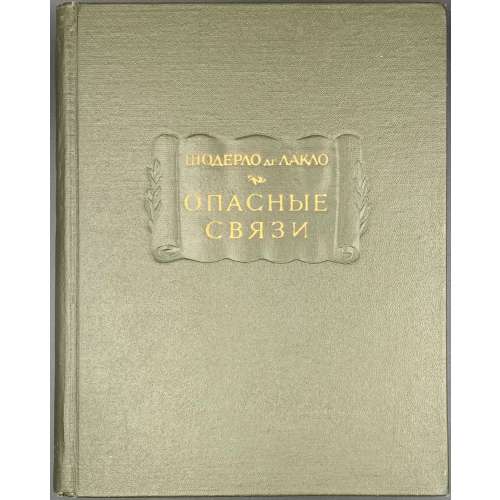 NEWHardcover, 220 x 180 mm, green buckram with gilt lettering on an embossed scroll to front cover and faded gilt lettering to spine (serial design), collated 8vo: 1-208 2110 228 (i.e. 178 leaves), pp. [1-4] 5-354 [2], errata slip laid in before back ffl. Title-page (red and black): ШОДЕРЛО де ЛАКЛО | ~ | ОПАСНЫЕ | СВЯЗИ | ~ | ПЕРЕВОД С ФРАНЦУЗСКОГО, | СТАТЬЯ И ПРИМЕЧАНИЯ | Н. Я. РЫКОВОЙ | ~ | ИЗДАТЕЛЬСТВО «НАУКА» | МОСКВА • ЛЕНИНГРАД | 1965 || Opposite t.p. (red and black): CHODERLOS de LACLOS | ~ | LES LIAISONS | DANGEREUSES | OU | LETTRES RECUEILLIES | DANS UNE SOCIÉTÉ | ET PUBLIÉES POUR L’INSTRUCTION | DE QUELQUES AUTRES | ~ || Series: АН СССР, Литературные памятники. Contributors: Choderlos de Laclos, Pierre Ambroise François (French, 1741 – 1803) – author. Рыкова, Надежда Януарьевна (Russian, 1901 – 1996) – translator Молок, Александр Иванович (Russian, 1898 – 1977) : Дворянство во Франции накануне буржуазной революции XVII века (pp. 317-335).
NEWHardcover, 220 x 180 mm, green buckram with gilt lettering on an embossed scroll to front cover and faded gilt lettering to spine (serial design), collated 8vo: 1-208 2110 228 (i.e. 178 leaves), pp. [1-4] 5-354 [2], errata slip laid in before back ffl. Title-page (red and black): ШОДЕРЛО де ЛАКЛО | ~ | ОПАСНЫЕ | СВЯЗИ | ~ | ПЕРЕВОД С ФРАНЦУЗСКОГО, | СТАТЬЯ И ПРИМЕЧАНИЯ | Н. Я. РЫКОВОЙ | ~ | ИЗДАТЕЛЬСТВО «НАУКА» | МОСКВА • ЛЕНИНГРАД | 1965 || Opposite t.p. (red and black): CHODERLOS de LACLOS | ~ | LES LIAISONS | DANGEREUSES | OU | LETTRES RECUEILLIES | DANS UNE SOCIÉTÉ | ET PUBLIÉES POUR L’INSTRUCTION | DE QUELQUES AUTRES | ~ || Series: АН СССР, Литературные памятники. Contributors: Choderlos de Laclos, Pierre Ambroise François (French, 1741 – 1803) – author. Рыкова, Надежда Януарьевна (Russian, 1901 – 1996) – translator Молок, Александр Иванович (Russian, 1898 – 1977) : Дворянство во Франции накануне буржуазной революции XVII века (pp. 317-335). -
 NEWSoftcover, 278 x 243 mm, French flapped pictorial wrappers with blue lettering and oval vignette in the middle to front, blue lettering to flaps; pp. [1-4] 5-113 [3], ISBN 88-8082-523-2. Title-page: Laclos en images | Editions illustrées de Liaisons dangereuses | réunies et présentées | par Michel Delon et Michèle Sajous D'Oria | Mario Adda Editore | PRESSES DE L'UNIVERSITE DE PARIS-SORBONNE || Imprint: (convex) le cabinet des curiosités | collection dirigée par Michel Delon | et Michèle Sajous D'Oria | (bottom left) ISBN 88-8082-523-2 | © Copyright 2003 | Mario Adda Editore - Via Tanzi. 59 – Bari | Tel e Fax 080/5539502 | Web: www.addaeditore.it | E-mail: addaeditore @addaeditore.it | Fotocomposizione: La Matrice – Bari | Stampa: Edizioni Pugliesi srI.- Martina Franca (Ta) || Contributors: Michel Delon (French, b. 1947) – author Michèl Sajous D’Oria – author
NEWSoftcover, 278 x 243 mm, French flapped pictorial wrappers with blue lettering and oval vignette in the middle to front, blue lettering to flaps; pp. [1-4] 5-113 [3], ISBN 88-8082-523-2. Title-page: Laclos en images | Editions illustrées de Liaisons dangereuses | réunies et présentées | par Michel Delon et Michèle Sajous D'Oria | Mario Adda Editore | PRESSES DE L'UNIVERSITE DE PARIS-SORBONNE || Imprint: (convex) le cabinet des curiosités | collection dirigée par Michel Delon | et Michèle Sajous D'Oria | (bottom left) ISBN 88-8082-523-2 | © Copyright 2003 | Mario Adda Editore - Via Tanzi. 59 – Bari | Tel e Fax 080/5539502 | Web: www.addaeditore.it | E-mail: addaeditore @addaeditore.it | Fotocomposizione: La Matrice – Bari | Stampa: Edizioni Pugliesi srI.- Martina Franca (Ta) || Contributors: Michel Delon (French, b. 1947) – author Michèl Sajous D’Oria – author -
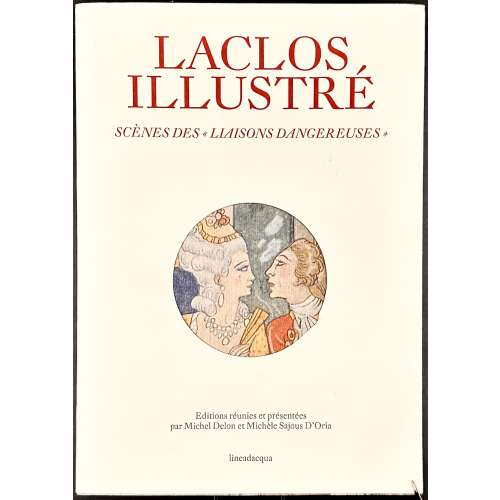 NEWSoftcover, 240 x 170 mm, creme dust jacket with red and black lettering and circular opening in the middle to front, red lettering to spine, over pictorial wrappers, pp. [1-8] 9-143 [1], ISBN 978-88-95598-25-3. 1st edition. Title-page (red and black): LACLOS | ILLUSTRE | « SCÈNES DES « LIAISONS DANGEREUSES» | Editions réunies et présentées | par Michel Delon et Michèle Sajous D'Oria | lineadacqua || Colophon: Imprimé à Venise, Italie | En février 2014 | Par Grafiche Veneziane || Publisher: Lineadacqua Edizioni; San Marco 3717/d, 30124 Venezia; www.lineadacqua.com Contributors: Michel Delon (French, b. 1947) – author Michèl Sajous D’Oria – author Contents: ILLUSTRATION ET INTERPRÉTATION – Michel Delon METTRE LES LETTRES ENSCÈNES – Michèle Sajous D'Oria LES LETTRES L'ÉCRITURE LE SECRET LA TRAHISON LE REFUS LA MARQUISE DE MERTEUIL LA PETITE MAISON LE CHEVALIER DE PRÉVAN LE RIVAL LE PIÈGE LE VICOMTE, DE VALMONT SÉDUCTIONS CÉCILE DE VOLANGES LA SURPRISE DES SENS LE VIOL LAPRÉSIDENTE DE TOURVEL L'AMOUR LA MORT FINALE Bibliographie des éditions illustrées Notices sur les illustrateurs
NEWSoftcover, 240 x 170 mm, creme dust jacket with red and black lettering and circular opening in the middle to front, red lettering to spine, over pictorial wrappers, pp. [1-8] 9-143 [1], ISBN 978-88-95598-25-3. 1st edition. Title-page (red and black): LACLOS | ILLUSTRE | « SCÈNES DES « LIAISONS DANGEREUSES» | Editions réunies et présentées | par Michel Delon et Michèle Sajous D'Oria | lineadacqua || Colophon: Imprimé à Venise, Italie | En février 2014 | Par Grafiche Veneziane || Publisher: Lineadacqua Edizioni; San Marco 3717/d, 30124 Venezia; www.lineadacqua.com Contributors: Michel Delon (French, b. 1947) – author Michèl Sajous D’Oria – author Contents: ILLUSTRATION ET INTERPRÉTATION – Michel Delon METTRE LES LETTRES ENSCÈNES – Michèle Sajous D'Oria LES LETTRES L'ÉCRITURE LE SECRET LA TRAHISON LE REFUS LA MARQUISE DE MERTEUIL LA PETITE MAISON LE CHEVALIER DE PRÉVAN LE RIVAL LE PIÈGE LE VICOMTE, DE VALMONT SÉDUCTIONS CÉCILE DE VOLANGES LA SURPRISE DES SENS LE VIOL LAPRÉSIDENTE DE TOURVEL L'AMOUR LA MORT FINALE Bibliographie des éditions illustrées Notices sur les illustrateurs -
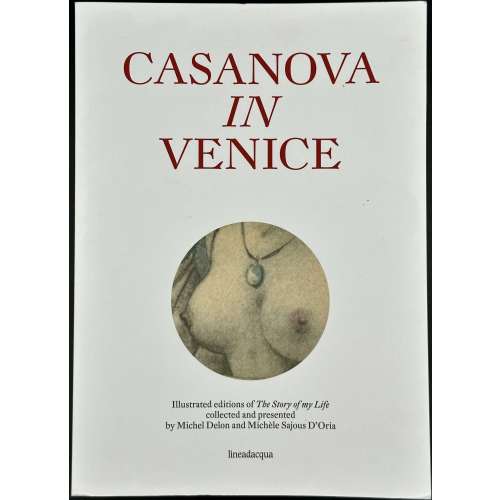 NEWSoftcover, 210 x 149 mm, white wrappers with red and black lettering and a vignette to front, red and black lettering to spine and black lettering to back; pp. [1-8] 9-143 [1]. ISBN 978-88-95598-98-7. Title-page (red and black): CASANOVA | IN | VENICE | Illustrated editions of The story of my life | collected and presented | by Michel Delon and Michèl Sajous D’Oria | lineadacqua || Colophon: Printed in Venice, Italy | In may 2019 | By Grafiche Veneziane, Venice || Back wrapper: 100 illustrations enrich | Casanova's own telling | of his adventures in Venice || First edition in French: April 2013 First edition in English: March 2019 Contributors: Michel Delon (French, b. 1947) – author Michèl Sajous D’Oria – author Lucian Comoy – translator Contents: A WORLD OFIMAGES – Michel Delon OF PLACES AND BOOKS – Michèle Sajous D'Oria PORTRAITS AND ALLEGORIES NANETTE AND MARTON VEDUTE C.C. A LETTER M.M. RENDEZ-VOUS AND AMBUSH THE CASINO AT THE OPERA AND THE RIDOTTO A MASKED BALL AT THE CONVENT THE QUADRILLE COMPARISON MELANCHOLY TONINE AND BARBERINE MASKS ARREST THE PIOMBI ADIEU VENICE Bibliography of the illustrated editions Notes concerning the illustrators
NEWSoftcover, 210 x 149 mm, white wrappers with red and black lettering and a vignette to front, red and black lettering to spine and black lettering to back; pp. [1-8] 9-143 [1]. ISBN 978-88-95598-98-7. Title-page (red and black): CASANOVA | IN | VENICE | Illustrated editions of The story of my life | collected and presented | by Michel Delon and Michèl Sajous D’Oria | lineadacqua || Colophon: Printed in Venice, Italy | In may 2019 | By Grafiche Veneziane, Venice || Back wrapper: 100 illustrations enrich | Casanova's own telling | of his adventures in Venice || First edition in French: April 2013 First edition in English: March 2019 Contributors: Michel Delon (French, b. 1947) – author Michèl Sajous D’Oria – author Lucian Comoy – translator Contents: A WORLD OFIMAGES – Michel Delon OF PLACES AND BOOKS – Michèle Sajous D'Oria PORTRAITS AND ALLEGORIES NANETTE AND MARTON VEDUTE C.C. A LETTER M.M. RENDEZ-VOUS AND AMBUSH THE CASINO AT THE OPERA AND THE RIDOTTO A MASKED BALL AT THE CONVENT THE QUADRILLE COMPARISON MELANCHOLY TONINE AND BARBERINE MASKS ARREST THE PIOMBI ADIEU VENICE Bibliography of the illustrated editions Notes concerning the illustrators -
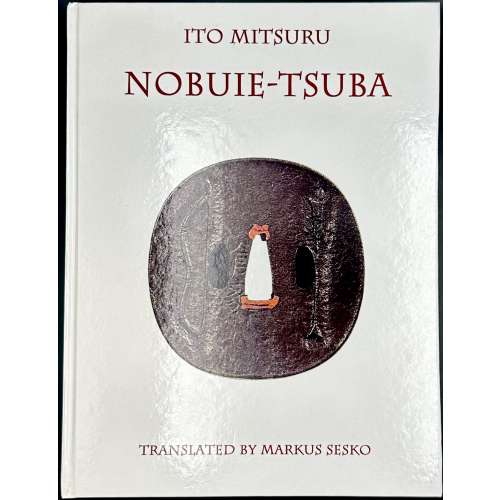 NEWHardcover, 280 x 121 mm, glossy white pictorial cover with mahogany lettering, pp. [1] 2-210 [2]. Lettering on the cover: ITŌ MITSURU | NOBUIE-TSUBA | {vignette} | TRANSLATED BY MARKUS SESKO || Title-page: Nobuie Tsuba | 信家鐔 | Itō Mitsuru (伊藤満) | translated by Markus Sesko | © 2016 Itō Mitsuru | Copyright translation: Markus Sesko | Print and Publishing: Lulu Press, Inc. ||
NEWHardcover, 280 x 121 mm, glossy white pictorial cover with mahogany lettering, pp. [1] 2-210 [2]. Lettering on the cover: ITŌ MITSURU | NOBUIE-TSUBA | {vignette} | TRANSLATED BY MARKUS SESKO || Title-page: Nobuie Tsuba | 信家鐔 | Itō Mitsuru (伊藤満) | translated by Markus Sesko | © 2016 Itō Mitsuru | Copyright translation: Markus Sesko | Print and Publishing: Lulu Press, Inc. || -
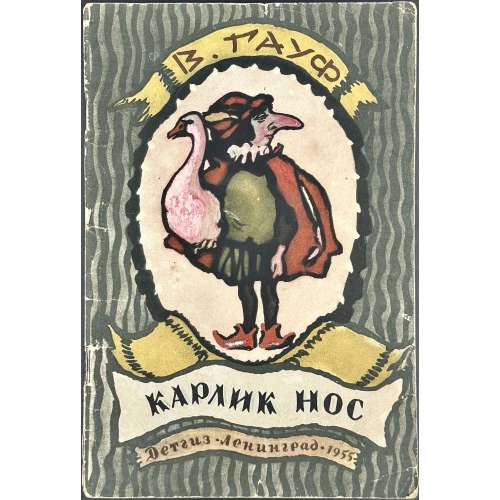 NEWSoftcover, publisher’s pictorial wrappers, stapled, 215 x 145 mm, pp.: [2] 3-38 [2], a few in-text and five full-page illustrations within collation; 8vo: 28 34, i.e. 20 leaves. Title-page: В. ГАУФ | {vignette} | КАРЛИК | НОС | ГОСУДАРСТВЕННОЕ ИЗДАТЕЛЬСТВО ДЕТСКОЙ ЛИТЕРАТУРЫ | МИНИСТЕРСТВА ПРОСВЕЩЕНИЯ РСФСР | ЛЕНИНГРАД | 1955 || Print run 200,000 copies. Contributors: Wilhelm Hauff [Вильгельм Гауф] (German, 1802 – 1827) – author. Шабанов, Иван Васильевич (Russian, 1906 – 1973) – artist.
NEWSoftcover, publisher’s pictorial wrappers, stapled, 215 x 145 mm, pp.: [2] 3-38 [2], a few in-text and five full-page illustrations within collation; 8vo: 28 34, i.e. 20 leaves. Title-page: В. ГАУФ | {vignette} | КАРЛИК | НОС | ГОСУДАРСТВЕННОЕ ИЗДАТЕЛЬСТВО ДЕТСКОЙ ЛИТЕРАТУРЫ | МИНИСТЕРСТВА ПРОСВЕЩЕНИЯ РСФСР | ЛЕНИНГРАД | 1955 || Print run 200,000 copies. Contributors: Wilhelm Hauff [Вильгельм Гауф] (German, 1802 – 1827) – author. Шабанов, Иван Васильевич (Russian, 1906 – 1973) – artist. -
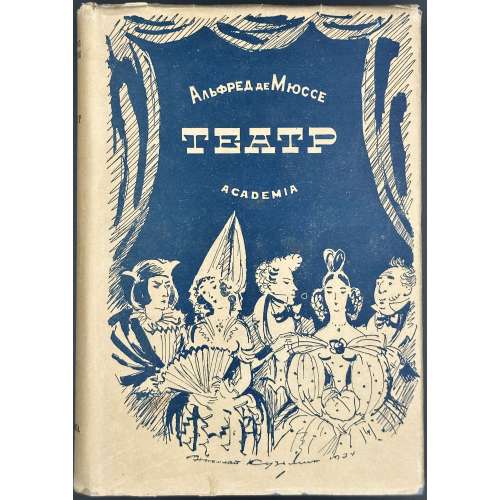 NEWHardcover volume, 8vo, 200 x 140 mm, bound in light blue cloth with vignette to front, cream printed label and lettering to flat spine; pictorial dust jacket, black lettering to spine, publisher’s device to back, and black lettering to flaps. Print-run 5,000 copies. Faux frontispieces, binding, and dust jacket designed by Н. В. Кузьмин. Collation: 1-388 394, i.e. 308 leaves plus 12 plates extraneous to collation, incl. frontispiece portrait of the author [1-7] 8-611 [5], errata slip tipped in. Title-page (blue and black): АЛЬФРЕД ДЕ МЮССЕ | ТЕАТР | Перевод, вступительная | статья и комментарии | А. В. Федорова | ACADEMIA | 1934 || Contre-title (blue and black): ФРАНЦУЗСКАЯ ЛИТЕРАТУРА | Под общей редакцией | А. М. Эфроса | АЛЬФРЕД ДЕ МЮССЕ | (1810 – 1857) | СОЧИНЕНИЯ | ACADEMIA | Москва – Ленинград || Title verso: ALFRED DE MUSSET | THÉÂTRE | Фронтисписы титулов, | переплет и супер-обложка | Н. В. Кузьмина || Catalogue Raisonné: Крылов-Кичатова 653 (p. 250). Contents: Венецианская ночь, или Свадьба Лауретты; Андреа дель Сарто; Фантазио; Любовью не шутят; Лоренцаччо; Подсвечник; Не надо биться об заклад; Молча за дело; Всего не предусмотришь; Беттина (пер. Е. Геркена) Contributors: Musset, Alfred de (French, 1810–1857) – author Фёдоров, Андрей Венедиктович (Russian, 1906 – 1997) – translator Геркен, Евгений Георгиевич (Russian, 1886 – 1962) – translator Кузьмин, Николай Васильевич (Russian, 1890 – 1987) – artist Эфрос, Абрам Маркович (Russian-Jewish, 1888 – 1954) – editor
NEWHardcover volume, 8vo, 200 x 140 mm, bound in light blue cloth with vignette to front, cream printed label and lettering to flat spine; pictorial dust jacket, black lettering to spine, publisher’s device to back, and black lettering to flaps. Print-run 5,000 copies. Faux frontispieces, binding, and dust jacket designed by Н. В. Кузьмин. Collation: 1-388 394, i.e. 308 leaves plus 12 plates extraneous to collation, incl. frontispiece portrait of the author [1-7] 8-611 [5], errata slip tipped in. Title-page (blue and black): АЛЬФРЕД ДЕ МЮССЕ | ТЕАТР | Перевод, вступительная | статья и комментарии | А. В. Федорова | ACADEMIA | 1934 || Contre-title (blue and black): ФРАНЦУЗСКАЯ ЛИТЕРАТУРА | Под общей редакцией | А. М. Эфроса | АЛЬФРЕД ДЕ МЮССЕ | (1810 – 1857) | СОЧИНЕНИЯ | ACADEMIA | Москва – Ленинград || Title verso: ALFRED DE MUSSET | THÉÂTRE | Фронтисписы титулов, | переплет и супер-обложка | Н. В. Кузьмина || Catalogue Raisonné: Крылов-Кичатова 653 (p. 250). Contents: Венецианская ночь, или Свадьба Лауретты; Андреа дель Сарто; Фантазио; Любовью не шутят; Лоренцаччо; Подсвечник; Не надо биться об заклад; Молча за дело; Всего не предусмотришь; Беттина (пер. Е. Геркена) Contributors: Musset, Alfred de (French, 1810–1857) – author Фёдоров, Андрей Венедиктович (Russian, 1906 – 1997) – translator Геркен, Евгений Георгиевич (Russian, 1886 – 1962) – translator Кузьмин, Николай Васильевич (Russian, 1890 – 1987) – artist Эфрос, Абрам Маркович (Russian-Jewish, 1888 – 1954) – editor -
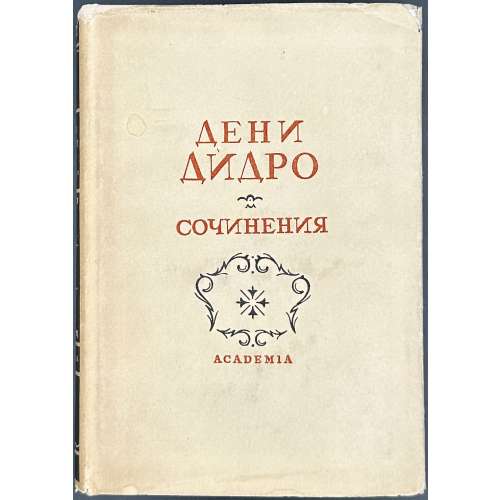 NEWTwo hardcover volumes, 8vo, 200 x 140 mm each, uniformly bound in cream cloth with gilt triple fillet frame to front, same blind to back, and blind volutes to corners, gilt lettering, fillets and blind fleurons in compartments to flat spine; cream dust jacket with red lettering and black vignette to front, black spine with cream lettering to spine, publisher’s device to back, and black lettering to flaps. Print-run 5,300 copies. Besides these two volumes, Academia later published volumes 5 (1936), 3, 4, and 8 (1937); other volumes were published in 1939-47 by ОГИЗ-Гослитиздат. Vol. 1: 1-318 324, i.e. 252 leaves plus 13 b/w plates extraneous to collation; pp.: [1-7] 8-501 [3]. Title-page (red and black): ДЕНИ ДИДРО | СОБРАНИЕ СОЧИНЕНИЙ | ТОМ I | ФИЛОСОФИЯ | Редакция и вступительная статья | И. К. Луппола | Перевод И. Б. Румера, | В. К. Сережникова, П. С. Юшкевича | Примечания А. Н. Лаврентьева | ACADEMIA | 1935 || Vol. 2: 1-368 374, i.e. 292 leaves plus 14 b/w plates extraneous to collation; pp.: [1-7] 8-582 [2]. Title-page (red and black): ДЕНИ ДИДРО | СОБРАНИЕ СОЧИНЕНИЙ | ТОМ II | ФИЛОСОФИЯ | Редакция и вступительная статья | И. К. Луппола | Перевод В. К. Сережникова и П. С. Юшкевича | Примечания М. Д. Цебенко| ACADEMIA | 1935 || In both volumes: Contre-Title: ФРАНЦУЗСКАЯ ЛИТЕРАТУРА | ДЕНИ ДИДРО | (1713 – 1784) | СОБРАНИЕ СОЧИНЕНИЙ | в десяти томах | Под общей редакцией | И. К. ЛУППОЛА | ACADEMIA | Москва – Ленинград || Title verso: DENIS DIDEROT | OEUVRES CHOISIES | Супер-обложка и переплет | Б. В. Шварца || Catalogue Raisonné: Крылов-Кичатова 723, 724 (pp. 261-2). Contributors: Denis Diderot (French, 1713 – 1784) Луппол, Иван Капитонович (Russian, 1896 – 1943) – killed in GULAG Румер, Исидор Борисович (Russian-Jewish, 1884 – 1938) – killed in GULAG Серёжников, Виктор Константинович (Russian, 1873 – 1944) – killed in GULAG Юшкевич, Павел Соломонович (Ukrainian-Jewish, 1873 – 1945) Цебенко, Мария Дмитриевна (Russian, ? – 1957) Шварц, Борис Владимирович (1906 – 1967) Лаврентьев, А. Н.
NEWTwo hardcover volumes, 8vo, 200 x 140 mm each, uniformly bound in cream cloth with gilt triple fillet frame to front, same blind to back, and blind volutes to corners, gilt lettering, fillets and blind fleurons in compartments to flat spine; cream dust jacket with red lettering and black vignette to front, black spine with cream lettering to spine, publisher’s device to back, and black lettering to flaps. Print-run 5,300 copies. Besides these two volumes, Academia later published volumes 5 (1936), 3, 4, and 8 (1937); other volumes were published in 1939-47 by ОГИЗ-Гослитиздат. Vol. 1: 1-318 324, i.e. 252 leaves plus 13 b/w plates extraneous to collation; pp.: [1-7] 8-501 [3]. Title-page (red and black): ДЕНИ ДИДРО | СОБРАНИЕ СОЧИНЕНИЙ | ТОМ I | ФИЛОСОФИЯ | Редакция и вступительная статья | И. К. Луппола | Перевод И. Б. Румера, | В. К. Сережникова, П. С. Юшкевича | Примечания А. Н. Лаврентьева | ACADEMIA | 1935 || Vol. 2: 1-368 374, i.e. 292 leaves plus 14 b/w plates extraneous to collation; pp.: [1-7] 8-582 [2]. Title-page (red and black): ДЕНИ ДИДРО | СОБРАНИЕ СОЧИНЕНИЙ | ТОМ II | ФИЛОСОФИЯ | Редакция и вступительная статья | И. К. Луппола | Перевод В. К. Сережникова и П. С. Юшкевича | Примечания М. Д. Цебенко| ACADEMIA | 1935 || In both volumes: Contre-Title: ФРАНЦУЗСКАЯ ЛИТЕРАТУРА | ДЕНИ ДИДРО | (1713 – 1784) | СОБРАНИЕ СОЧИНЕНИЙ | в десяти томах | Под общей редакцией | И. К. ЛУППОЛА | ACADEMIA | Москва – Ленинград || Title verso: DENIS DIDEROT | OEUVRES CHOISIES | Супер-обложка и переплет | Б. В. Шварца || Catalogue Raisonné: Крылов-Кичатова 723, 724 (pp. 261-2). Contributors: Denis Diderot (French, 1713 – 1784) Луппол, Иван Капитонович (Russian, 1896 – 1943) – killed in GULAG Румер, Исидор Борисович (Russian-Jewish, 1884 – 1938) – killed in GULAG Серёжников, Виктор Константинович (Russian, 1873 – 1944) – killed in GULAG Юшкевич, Павел Соломонович (Ukrainian-Jewish, 1873 – 1945) Цебенко, Мария Дмитриевна (Russian, ? – 1957) Шварц, Борис Владимирович (1906 – 1967) Лаврентьев, А. Н. -
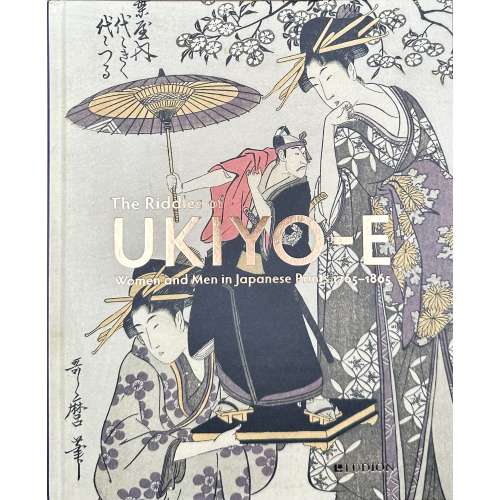 Hardcover volume 295 x 240 mm, pictorial front cover and purple spine with gilt embossed lettering, back cover with orange lettering, craft endpapers, pp.: [1-6] 7-255 [1], profusely illustrated. Exhibition catalogue with 123 reproductions of Japanese woodblock prints. Title-page: The Riddles of | UKIYO-E | Women and Men in Japanese Prints 1765–1865 | Chris Uhlenbeck / Jim Dwinger / Josephine Smit | {publisher’s device LUDION} || Table of contents: Preface; Introduction; Beauties; Shunga; Legends; Kabuki; INDEX; LIST OF WORKS; BIBLIOGRAPHY; AUTHORS.
Hardcover volume 295 x 240 mm, pictorial front cover and purple spine with gilt embossed lettering, back cover with orange lettering, craft endpapers, pp.: [1-6] 7-255 [1], profusely illustrated. Exhibition catalogue with 123 reproductions of Japanese woodblock prints. Title-page: The Riddles of | UKIYO-E | Women and Men in Japanese Prints 1765–1865 | Chris Uhlenbeck / Jim Dwinger / Josephine Smit | {publisher’s device LUDION} || Table of contents: Preface; Introduction; Beauties; Shunga; Legends; Kabuki; INDEX; LIST OF WORKS; BIBLIOGRAPHY; AUTHORS. -
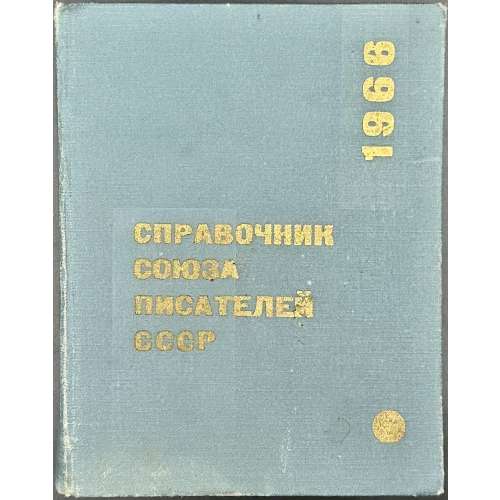 Hardcover, 17 x 13 cm, grey cloth, gelt lettering to front and spine, pp.: [1-6] 7-671 [1], errata slip tipped-in at pp 2/3, plus laid-in 16 pp booklet Дополнение к справочнику Союза Писателей СССР 1966 г. по состоянию на 15. I. 66 г. Title-page: СОЮЗ ПИСАТЕЛЕЙ СССР | СПРАВОЧНИК | Составлен по данным | на 1 ноября 1965 года | СОВЕТСКИЙ ПИСАТЕЛЬ | МОСКВА 1966 || On page 104: Варшавский Сергей Петрович (критик, литературовед) – г. Ленинград Ф-13, Серпуховская ул., д. 2, кв. 24, тел. К 2-14-46. Print run: 6,000 copies.
Hardcover, 17 x 13 cm, grey cloth, gelt lettering to front and spine, pp.: [1-6] 7-671 [1], errata slip tipped-in at pp 2/3, plus laid-in 16 pp booklet Дополнение к справочнику Союза Писателей СССР 1966 г. по состоянию на 15. I. 66 г. Title-page: СОЮЗ ПИСАТЕЛЕЙ СССР | СПРАВОЧНИК | Составлен по данным | на 1 ноября 1965 года | СОВЕТСКИЙ ПИСАТЕЛЬ | МОСКВА 1966 || On page 104: Варшавский Сергей Петрович (критик, литературовед) – г. Ленинград Ф-13, Серпуховская ул., д. 2, кв. 24, тел. К 2-14-46. Print run: 6,000 copies. -
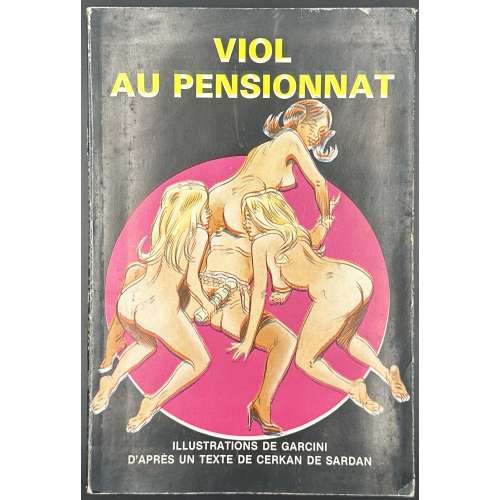 Softcover, French flapped pictorial wrappers, 240 x 160 mm, translated title: Rape at the boarding school, pp. [1-6] 7-164 [4], 40 black and white illustrations by Garcini. Title-page: D’après un texte de | CERKAN DE SARDAN | VIOL | AU PENSIONNAT | illustrations de | GARCINI ||
Softcover, French flapped pictorial wrappers, 240 x 160 mm, translated title: Rape at the boarding school, pp. [1-6] 7-164 [4], 40 black and white illustrations by Garcini. Title-page: D’après un texte de | CERKAN DE SARDAN | VIOL | AU PENSIONNAT | illustrations de | GARCINI || -
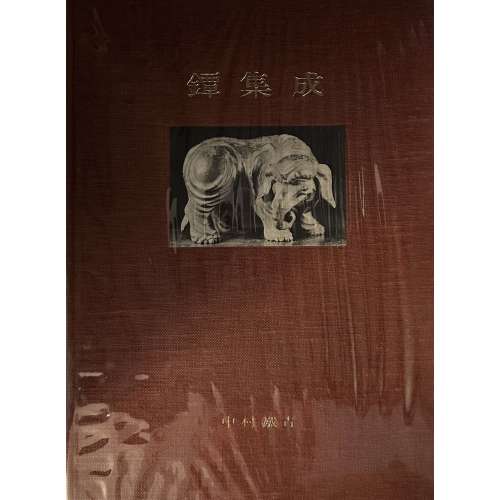 A large hardcover volume, 370 x 265 x 53 mm, bound in burgundy cloth with pasted-in b/w photograph and gilt lettering to front, gilt lettering to spine, in plastic dust jacket, in a slipcase, in a cardboard shipping box, pp. [2] 1-522 [2], 128 leaves total; limited edition of 1000 copies. Author: Nakamura Tessei [中村鐵青] Seller's description: Tsuba Shusei by Nakamura. 1963. Of a limited edition of 1,000. Clothbound with plastic jacket, slipcase, and cardboard storage box, 11 ½ x 14 ½”, 522 heavy stock pages in Japanese. This is a very impressive book. Thousands of tsuba, from Kamakura to late Edo and arranged by school. are illustrated (24 in colour photos and the rest in black & white) and described. If there is a tsuba bible this might be it; there can’t be a more comprehensive book on the subject. The storage box is shelf worn, the slipcase is just a bit toned; the book is in excellentt condition. Produced by Chuokoron-Shinsha, Inc. [株式会社中央公論新社] Publisher: 銀集成刊行会 Production details: 鐵集成 第617番 昭和38年2月10日発行 限定1,000部 定価 10,000円 オフセット単色印刷:マイク印刷 オフセット原色印刷:大日本印刷 著者中村鐵青 製作 中央公論事業出版 発行所 銀集成刊行会 活版印刷:精興社 製本:協和製本 本文用紙:三菱製紙 表紙:望月
A large hardcover volume, 370 x 265 x 53 mm, bound in burgundy cloth with pasted-in b/w photograph and gilt lettering to front, gilt lettering to spine, in plastic dust jacket, in a slipcase, in a cardboard shipping box, pp. [2] 1-522 [2], 128 leaves total; limited edition of 1000 copies. Author: Nakamura Tessei [中村鐵青] Seller's description: Tsuba Shusei by Nakamura. 1963. Of a limited edition of 1,000. Clothbound with plastic jacket, slipcase, and cardboard storage box, 11 ½ x 14 ½”, 522 heavy stock pages in Japanese. This is a very impressive book. Thousands of tsuba, from Kamakura to late Edo and arranged by school. are illustrated (24 in colour photos and the rest in black & white) and described. If there is a tsuba bible this might be it; there can’t be a more comprehensive book on the subject. The storage box is shelf worn, the slipcase is just a bit toned; the book is in excellentt condition. Produced by Chuokoron-Shinsha, Inc. [株式会社中央公論新社] Publisher: 銀集成刊行会 Production details: 鐵集成 第617番 昭和38年2月10日発行 限定1,000部 定価 10,000円 オフセット単色印刷:マイク印刷 オフセット原色印刷:大日本印刷 著者中村鐵青 製作 中央公論事業出版 発行所 銀集成刊行会 活版印刷:精興社 製本:協和製本 本文用紙:三菱製紙 表紙:望月 -
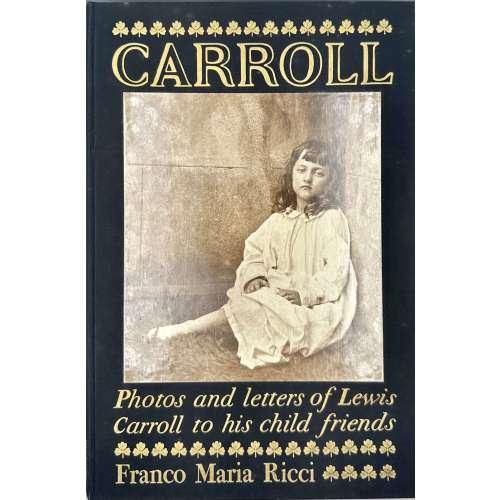 Hardcover volume, 355 x 240 mm, bound in black cloth with gilt lettering to front and spine with a photo portrait of Mary Millais (1860-1944), in a black cloth clam-shell box 370 x 253 x 40 mm, with a shamrock diaper black paper adorned with publisher’s coat of arms pasted to the front. Pp.: [1-12] 13-213 [3], with 41 glued-in photomechanically reproduced photographs, chiefly from the Gernsheim Collection at the University of Texas, two of them of Alice Liddell (pp. 123 and 127). Printed on hand-made blue laid paper. Edition is limited to 3,000 copies, of which this is copy № 1200. Title-page: Lewis Carroll | Photos and Letters | to His Child Friends | Edited by Guido Almansi | Notes by | Brassai and Helmut Gernsheim | Franco Maria Ricci | 1975 || Colophon: This volume was printed in Milan, Italy, in the month of November 1975, under the direction of Franco Maria Ricci. The hand-made paper is the work of the Pietro Miliani mills at Fabriano. This first edition consists of three thousand numbered copies. Copy n. [1200]. Facsimile. Seller’s description: Near Fine condition Hardcover Signed by Franco Maria Ricci on the colophon page, Numbered and Limited Edition #1200/3000 of copies. Includes Notes by Brassai and Helmut Gernsheim, with 41 tipped-in sepia-toned photographs, 213 pages. "The Signs of Man Volume 3". Black boards bound in Orient silk with gold engraved lettering on the spine and cover and a sepia-toned photograph affixed to the front cover, handmade Ingres pastel paper manufactured by Cartiere Milliani in Fabrianoo with decorated endpapers and deckled fore-edge. Housed in a black clamshell case with clover leaf pattern in Very Good + condition with the exception that there is no spine label and very light wear to the extremities. Oversize folio: 9" x 13 3/4" Contributors: Carroll, Lewis (British, 1832 – 1898) – Author/Photographer Ricci, Franco Maria (Italian, 1937 – 2020) – publisher Almansi, Guido (Italian, 1931 – 2001) – editor Brassai [Halász, Gyula] (Hungarian–French, 1899 – 1984) – notes Gernsheim, Helmut (Jewish-German, 1913 – 20 July 1995) – notes
Hardcover volume, 355 x 240 mm, bound in black cloth with gilt lettering to front and spine with a photo portrait of Mary Millais (1860-1944), in a black cloth clam-shell box 370 x 253 x 40 mm, with a shamrock diaper black paper adorned with publisher’s coat of arms pasted to the front. Pp.: [1-12] 13-213 [3], with 41 glued-in photomechanically reproduced photographs, chiefly from the Gernsheim Collection at the University of Texas, two of them of Alice Liddell (pp. 123 and 127). Printed on hand-made blue laid paper. Edition is limited to 3,000 copies, of which this is copy № 1200. Title-page: Lewis Carroll | Photos and Letters | to His Child Friends | Edited by Guido Almansi | Notes by | Brassai and Helmut Gernsheim | Franco Maria Ricci | 1975 || Colophon: This volume was printed in Milan, Italy, in the month of November 1975, under the direction of Franco Maria Ricci. The hand-made paper is the work of the Pietro Miliani mills at Fabriano. This first edition consists of three thousand numbered copies. Copy n. [1200]. Facsimile. Seller’s description: Near Fine condition Hardcover Signed by Franco Maria Ricci on the colophon page, Numbered and Limited Edition #1200/3000 of copies. Includes Notes by Brassai and Helmut Gernsheim, with 41 tipped-in sepia-toned photographs, 213 pages. "The Signs of Man Volume 3". Black boards bound in Orient silk with gold engraved lettering on the spine and cover and a sepia-toned photograph affixed to the front cover, handmade Ingres pastel paper manufactured by Cartiere Milliani in Fabrianoo with decorated endpapers and deckled fore-edge. Housed in a black clamshell case with clover leaf pattern in Very Good + condition with the exception that there is no spine label and very light wear to the extremities. Oversize folio: 9" x 13 3/4" Contributors: Carroll, Lewis (British, 1832 – 1898) – Author/Photographer Ricci, Franco Maria (Italian, 1937 – 2020) – publisher Almansi, Guido (Italian, 1931 – 2001) – editor Brassai [Halász, Gyula] (Hungarian–French, 1899 – 1984) – notes Gernsheim, Helmut (Jewish-German, 1913 – 20 July 1995) – notes -
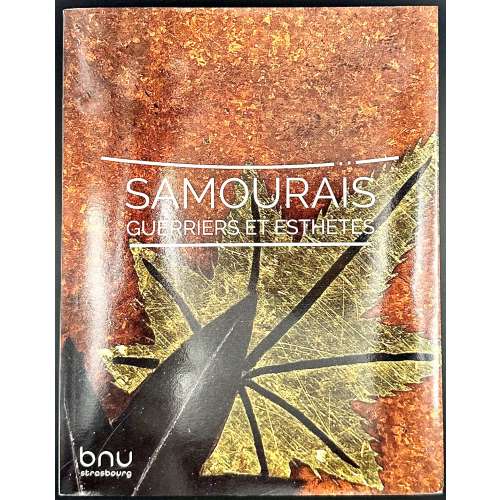 Softcover, 270 x 210 mm, publisher’s flapped pictorial wrappers, in identical dust jacket, pp. [1-4] 5-189 [3], illustrated throughout with 192 collection items. ISBN 978-2-85923-092-0 Title-page (sanguine): — | SAMOURAÏS | GUERRIERS ET ESTHÈTES | — | CATALOGUE DE L'EXPOSITION | ORGANISÉE A LA BIBLIOTHÉQUE | NATIONALE ET UNIVERSITAIRE | STRASBOURG | 11 MARS – 13 JUILLET 2022 | SOUS LA DIRECTION | DE PATRICK LIEBERMANN, | EMMANUEL MARINE | ET DELPHINE MULARD | ASSISTÉS PAR AGATHE JACQUEMIN | bnu | STRASBOURG || Publisher: Bibliothèque Nationale et Universitaire (Strasbourg) In this collection: TSU-0437.2024
Softcover, 270 x 210 mm, publisher’s flapped pictorial wrappers, in identical dust jacket, pp. [1-4] 5-189 [3], illustrated throughout with 192 collection items. ISBN 978-2-85923-092-0 Title-page (sanguine): — | SAMOURAÏS | GUERRIERS ET ESTHÈTES | — | CATALOGUE DE L'EXPOSITION | ORGANISÉE A LA BIBLIOTHÉQUE | NATIONALE ET UNIVERSITAIRE | STRASBOURG | 11 MARS – 13 JUILLET 2022 | SOUS LA DIRECTION | DE PATRICK LIEBERMANN, | EMMANUEL MARINE | ET DELPHINE MULARD | ASSISTÉS PAR AGATHE JACQUEMIN | bnu | STRASBOURG || Publisher: Bibliothèque Nationale et Universitaire (Strasbourg) In this collection: TSU-0437.2024
 Contributors Collective:
Emmanuel Marine
Delphine Mulard
Patrick Liebermann
Agathe Jacquemin
Contributors Collective:
Emmanuel Marine
Delphine Mulard
Patrick Liebermann
Agathe Jacquemin -
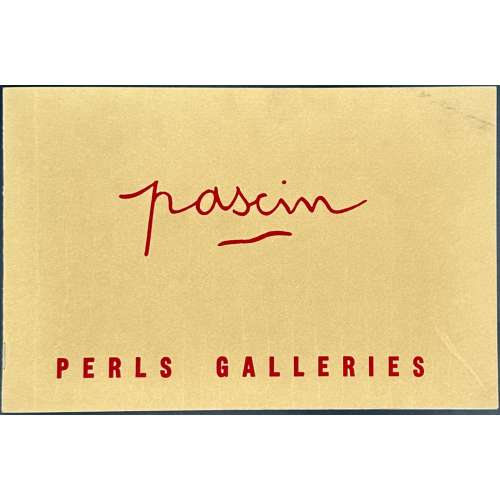 Four exhibition catalogues at Perls Galleries in NYC, coloured stiff laid paper wrappers, colour lettering, staples, b/w plates: September 22 - October 25, 1952, 8 pp; November 14 - December 24, 1955, 12 pp.; “The Nude” January 5 - February 7, 1959. 16 pp.; Portraits and Models November 20 - December 29, 1962, 12 pp. Size: 155 x 240 mm each.
Four exhibition catalogues at Perls Galleries in NYC, coloured stiff laid paper wrappers, colour lettering, staples, b/w plates: September 22 - October 25, 1952, 8 pp; November 14 - December 24, 1955, 12 pp.; “The Nude” January 5 - February 7, 1959. 16 pp.; Portraits and Models November 20 - December 29, 1962, 12 pp. Size: 155 x 240 mm each. -
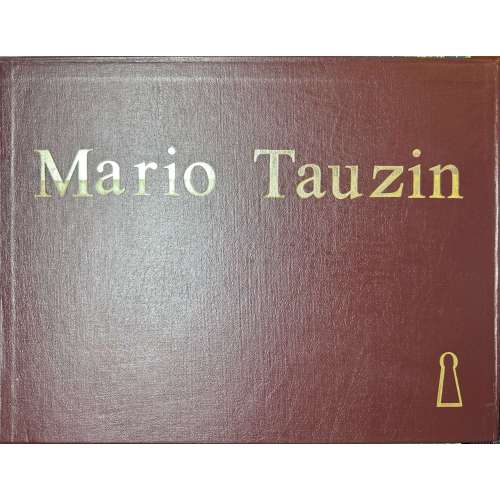 Set of 30 lithographic plates printed on watermarked Van Gelder Simili Japon wove paper, loose in two rexine-backed stiff paper wrappers, 15 in each, together in rexine portfolio with gilt lettering and keyhole on front cover. According to the seller, these are facsimiles of prints/ drawings by Mario Tauzin. Scenes from the series 'Interdit aux adultes'. No publisher indicated; printed in about 1950—a limited edition. Six of these designs used to illustrate 'Bonne à tout faire' were published by Éric Losfeld in the late 1950s (LIB-3293.2024). Dimensions: sheet 320 x 420 mm; album 330 x 430 mm. Contributor: Mario Tauzin (French, 1909 – 1979) — artist
Set of 30 lithographic plates printed on watermarked Van Gelder Simili Japon wove paper, loose in two rexine-backed stiff paper wrappers, 15 in each, together in rexine portfolio with gilt lettering and keyhole on front cover. According to the seller, these are facsimiles of prints/ drawings by Mario Tauzin. Scenes from the series 'Interdit aux adultes'. No publisher indicated; printed in about 1950—a limited edition. Six of these designs used to illustrate 'Bonne à tout faire' were published by Éric Losfeld in the late 1950s (LIB-3293.2024). Dimensions: sheet 320 x 420 mm; album 330 x 430 mm. Contributor: Mario Tauzin (French, 1909 – 1979) — artist


